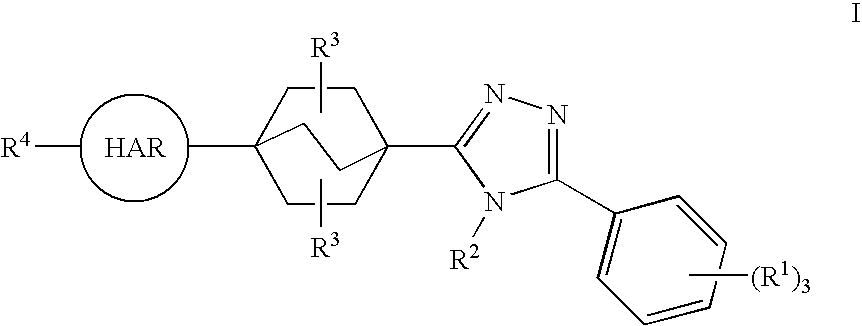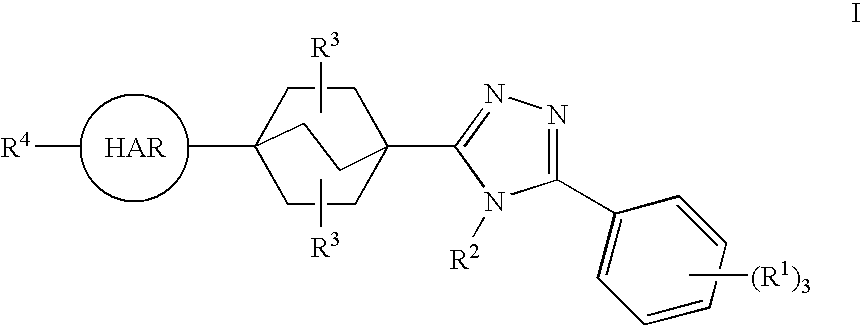Triazole Derivatives as Inhibitors of 11-Beta-Hydroxysteroid Dehydrogenase-1
a technology of steroid dehydrogenase and derivatives, which is applied in the field of triazole derivatives, can solve the problems of reduced effect of insulin in stimulating glucose and lipid metabolism in the main insulin-sensitive tissues, namely, muscle, liver and adipose tissues, and increased risk of cardiovascular complications, so as to reduce insulin secretion, improve glucose-stimulated insulin secretion, and reduce intraocular pressure
- Summary
- Abstract
- Description
- Claims
- Application Information
AI Technical Summary
Benefits of technology
Problems solved by technology
Method used
Image
Examples
example 1
[0171]
3-(4-{4-Methyl-5-[2-(trifluoromethyl)phenyl]-4H-1,2,4-triazol-3-yl}bicyclo[2.2.2]oct-1-1yl)-5-(4,4,4-trifluorobutyl)-1,2,4-oxadiazole (1-G)
[0172]
Step A:
methyl 4-[(methylamino)carbonyl]bicyclo[2.2.2]octane-1-carboxylate (1-B)
[0173]4-(Methoxycarbonyl)bicyclo[2.2.2]octane-1-carboxylic acid 1-A (Chapman, N. B. et al. J. Org. Chem., 1970, 35, 917) (4.0 g, 18.9 mmol) was dissolved in 12 mL of anhydrous methylene chloride under a nitrogen atmosphere, treated with oxalyl chloride (2M in methylene chloride, 28 mL, 56 mmol) and subsequently with 0.5 ml of DMF. The reaction was stirred at room temperature under a nitrogen atmosphere for 90 min, then evaporated and placed under vacuum for 20 min. The reaction was concentrated and stripped from toluene 3 times. The acid chloride was dissolved in anhydrous methylene chloride (75 mL), cooled in an ice-bath, and then treated dropwise with a solution of methylamine (2M in THF, 57 mL, 113 mmol). Upon addition of the amine, the cooling bath was ...
examples 2-12
[0179]Following procedures similar to those described above, the following compounds of formula I were also prepared:
Ex.Parent Ion#acidR4(M + 1)2530.473512.314540.495512.486514.337528.368514.489584.4810560.2011498.1012516.11
example 13
[0180]
2-(4-{4-methyl-5-[2-(trifluoromethyl)phenyl]-4H-1,2,4-triazol-3-yl}bicyclo[2.2.2]oct-1-yl)-5-(3,3,3-trifluoro-1-methylpropyl)-1,34-oxadiazole (13-C)
[0181]
Step A:
4-{4-methyl-5-[2-(trifluoromethyl)phenyl]-4H-1,2,4-triazol-3-yl}bicyclo[2.2.2]octane-1-carbohydrazide (13-A)
[0182]A portion of solid (4-{4-methyl-5-[2-(trifluoromethyl)phenyl]-4H-1,2,4-triazol-3-yl}bicyclo[2.2.2]octane-1-carboxylic acid 1-D (2.0 g, 5.27 mmol) was dissolved in anhydrous DMF (30 ml) and treated with N,N,N′,N′-tetramethylformamidinium hexafluorophosphate (2.09 g, 7.91 mmol), triethyl amine (2.3 mL, 16.50 mmol), and hydrazine (0.50 mL, 15.93 mmol) at room temperature and a nitrogen atmosphere overnight. The solvent was removed in vacuo, and the residue was redissolved in methylene chloride (700 ml) and washed with saturated aqueous sodium bicarbonate, water, and brine. The product was dried over MgSO4 and the solvent removed to afford 13-A as a white powder. MS (ESI+)=394.13 (M+1).
Step B:
4-{-4-methyl-5-[2-...
PUM
| Property | Measurement | Unit |
|---|---|---|
| temperature | aaaaa | aaaaa |
| pH | aaaaa | aaaaa |
| time | aaaaa | aaaaa |
Abstract
Description
Claims
Application Information
 Login to View More
Login to View More - R&D
- Intellectual Property
- Life Sciences
- Materials
- Tech Scout
- Unparalleled Data Quality
- Higher Quality Content
- 60% Fewer Hallucinations
Browse by: Latest US Patents, China's latest patents, Technical Efficacy Thesaurus, Application Domain, Technology Topic, Popular Technical Reports.
© 2025 PatSnap. All rights reserved.Legal|Privacy policy|Modern Slavery Act Transparency Statement|Sitemap|About US| Contact US: help@patsnap.com



